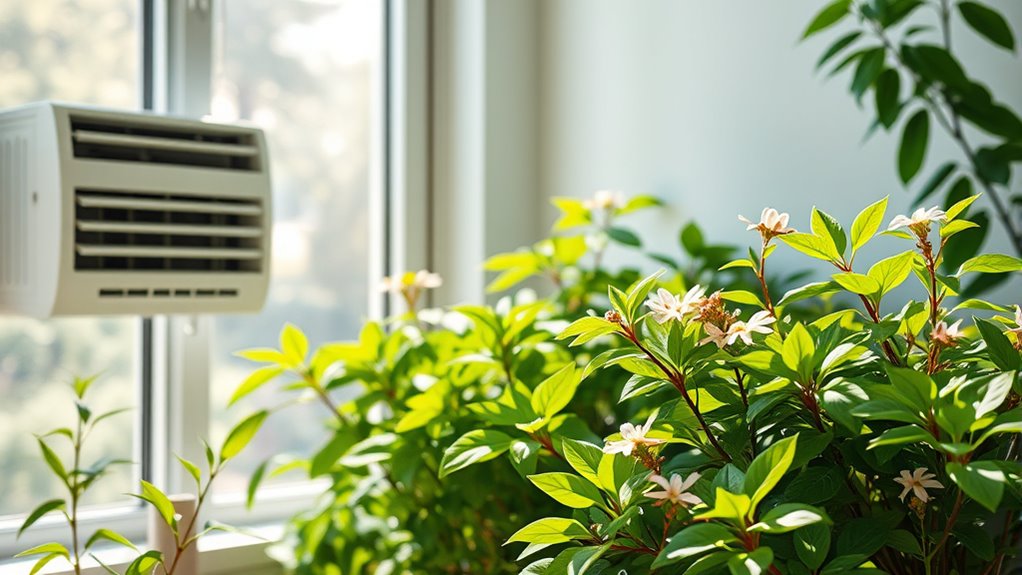To balance your indoor climate for plant health during summer, you need to use your air conditioner wisely. It should control humidity and temperature without making the air too dry or too cold. Proper settings prevent mold, mildew, and plant stress while supporting comfort for you. Consistent maintenance, like cleaning filters, helps your system run efficiently. Keep an eye on these factors to guarantee a healthy environment—there’s more to discover about achieving ideal results.
Key Takeaways
- Proper humidity and temperature regulation prevent plant stress, fungal growth, and dehydration during summer heat.
- Maintaining balanced indoor conditions supports healthy plant growth and reduces risks of pests and diseases.
- Regular system maintenance ensures effective climate control, avoiding overly dry or cold environments harmful to plants.
- Adjusting AC settings to prevent excessive dryness or humidity fluctuations helps sustain optimal plant health.
- Monitoring indoor climate in summer promotes comfort for humans and vitality for plants, reducing health and growth issues.

Have you ever wondered how air conditioning impacts your environment and health? When summer heat intensifies, turning on your AC becomes second nature, but it’s crucial to understand how it influences more than just your comfort. Proper air conditioning manages humidity control and temperature regulation, both essential for maintaining a healthy indoor environment. Without these controls, your space can become too dry or too moist, creating conditions that affect your well-being and plant health alike. Humidity management is a vital aspect, as it influences indoor air quality and the growth conditions for many plants. Humidity control is a key aspect of effective air conditioning. If the air is too humid, mold and mildew can develop, which not only damages your home but also poses health risks like allergies and respiratory issues. Conversely, overly dry air can lead to dry skin, irritated eyes, and respiratory discomfort. An air conditioner that properly balances humidity levels helps keep the air just right, reducing these risks. This balance is especially critical if you’re growing plants indoors, as many plants thrive within specific humidity ranges. Too little moisture can cause wilting or slow growth, while too much can promote fungal diseases. By maintaining ideal humidity, your AC supports not only your health but also your plants’ vitality.
Temperature regulation is equally important. When your AC cools the air, it prevents indoor temperatures from soaring to uncomfortable or even dangerous levels. Consistent temperature regulation helps you feel more comfortable and can improve sleep quality, productivity, and overall mood. For plants, stable temperatures are essential. Fluctuations can stress them out, hinder growth, or even kill delicate species. An efficient air conditioning system ensures that indoor temperatures stay within a safe range, providing a stable environment for your plants to flourish. It also helps prevent heat stress, which can cause plants to droop or drop leaves, and reduces the risk of pests that thrive in hot, stagnant conditions. Additionally, understanding the role of attention in maintaining consistent settings can significantly enhance your system’s efficiency.
But beware—over-reliance on air conditioning without proper settings can lead to overly dry air or excessively cold environments. That’s why understanding how your AC manages both humidity control and temperature regulation is crucial. When set correctly, it creates a balanced indoor climate where you and your plants can thrive. Regular maintenance, like cleaning filters and monitoring settings, ensures your system works efficiently, providing the ideal environment year-round. In summer, this balance becomes even more critical, as outdoor heat and humidity levels fluctuate. By harnessing the full potential of your air conditioning system, you create a healthier, more comfortable space that promotes well-being and supports your plants’ growth.
Frequently Asked Questions
How Can I Prevent Air Conditioning From Causing Plant Dehydration?
To prevent your plants from dehydration, focus on maintaining proper plant moisture and managing airflow. Guarantee they aren’t exposed directly to cold, dry air from the AC, which can strip moisture. Use a humidifier or place water trays nearby to boost humidity. Adjust airflow so it circulates gently around your plants, avoiding direct drafts. Regularly check soil moisture and water when the topsoil feels dry to keep your plants healthy.
What Humidity Levels Are Ideal for Indoor Plants With AC?
You should aim for humidity levels between 40-60% to support your indoor plants with AC. Proper humidity management helps maintain plant hydration, preventing dehydration caused by dry indoor air. Use a humidifier or place water trays nearby if the air gets too dry. Regularly monitor humidity with a gauge, and adjust as needed to create a suitable environment that keeps your plants healthy and well-hydrated during summer.
How Often Should I Water Plants Exposed to AC Airflow?
Worried about watering frequency and plant hydration? When plants face ac airflow, they often need more frequent watering because the dry air accelerates dehydration. Check soil moisture regularly and water when the top inch feels dry. Typically, you might water every 2-3 days, but always tailor your approach based on the plant’s specific needs and environment. Consistent care keeps your plants healthy, happy, and hydrated amidst the cool currents.
Can Air Conditioning Spread Plant Diseases Indoors?
You might wonder if air conditioning can spread plant diseases indoors. Yes, it can, by circulating airborne spores and facilitating pest transmission. When the AC runs, it moves air around, which can carry fungal spores or pests from infected plants to healthy ones. To minimize this risk, keep your plants healthy, clean your filters regularly, and avoid placing new or sick plants near others while the AC is on.
What Are the Best Plant Species for Ac-Controlled Environments?
Think of your indoor space as a delicate dance floor; choosing the right plants guarantees they thrive under your AC’s rhythm. For your environment, select species like pothos, snake plants, or ZZ plants—they’re resilient, requiring low to moderate light, and thrive in controlled climates. Proper plant selection and understanding their light needs help you keep greenery healthy, even when the indoor climate shifts due to air conditioning.
Conclusion
By balancing the benefits and barriers of air conditioning, you can create a comfortable, consistent climate that cultivates your plants’ vibrancy. Adjusting settings, avoiding abrupt changes, and maintaining proper humidity helps prevent problems and promotes plant prosperity. Remember, your mindful management makes a meaningful difference—making summer’s stressors subtle and supporting your plants’ health. With careful control, you’ll cultivate a thriving, lush landscape, turning turbulent temperatures into tranquil, thriving terrain.










